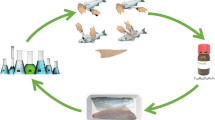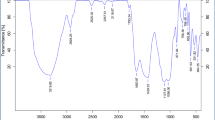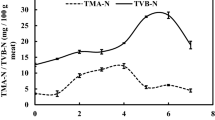Abstract
The present study aimed to assess the effectiveness of sodium-acetate dip treatment (2%) on the quality and shelf life of seer fish (Scomberomorus commerson) steaks during chilled condition. For this, the seer fish steaks were packed in multilayered EVOH pouches having oxygen permeability of 3.86 cc m−2 24 h−1 at 1 atm. pressure and water vapour transmission rate of 139.02 g m−2 24 h−1 at 37 °C and 92% RH, and maintained at 1–2 °C for quality evaluation. The initial mesophilic and psychrotrophic bacterial load of the seer fish steaks was 4.48 and 4.47 log cfu g−1, respectively, which showed a lag phase in treated samples compared to control. The limit of 7 log cfu g−1 was exceeded on 15 and 24th days for seer fish steaks in control air pack and NaA-treated samples, respectively, for both mesophilic and psychrotrophic counts. Lipid oxidation was significantly higher for control sample compared to treated sample throughout the storage period. Formation of volatile bases and degradation of nucleotide breakdown products were significantly (P < 0.05) inhibited in the sodium-acetate-treated samples resulting in a shelf life of 21 days compared to only 12 days for control samples.





Similar content being viewed by others
References
Sloan AE (2007) Great ideas from around the world. Food Technol 61(10):21–33
Mohan CO, Ravishankar CN, Srinivasa Gopal TK (2008) Effect of O2-scavenger on the shelf-life of catfish (Pangasius sutchi) steaks during chilled storage. J Sci Food Agric 88:442–448
Mohan CO, Ravishankar CN, Srinivasa Gopal TK, Lalitha KV (2010) Effect of reduced oxygen atmosphere and sodium acetate treatment on the microbial quality changes of Seer fish (Scomberomorus commerson) steaks stored in ice. Food Microbiol 27:526–534
Mohan CO, Ravishankar CN, Srinivasa Gopal TK, Lalitha KV (2012) Effect of chitosan edible coating on the quality of double filleted Indian oil sardine (Sardinella longiceps) during chilled storage. Food Hydrocol 26(1):167–174
Ozogul Y, Ozogul F, Gokbulut C (2006) Quality assessment of wild European eel (Anguilla anguilla) stored in ice. Food Chem 95:458–465
Ozogul Y, Ozogul F, Kuley E, Ozkutuk AS, Gokbulut C, Kose S (2006) Biochemical, sensory and microbiological attributes of wild turbot (Scophthalmus maximus), from the Black Sea, during chilled storage. Food Chem 99:752–758
Ozogul F, Kuley E, Ozogul Y (2007) Sensory, chemical and microbiological quality parameters in sea bream (Sparus aurata) stored in ice or wrapped in cling film or in aluminium foil at 2 ± 1 °C. Int J Food Sci Technol 42:903–909
Manju S, Mohan CO, Mallick AK, Ravishankar CN, Srinivasa Gopal TK (2008) Influence of vacuum packaging and organic acid treatment on the chilled shelf life of pearl spot (Etroplus suratensis, Bloch 1970). J Food Qual 31:347–365
Lee YL, Cesario T, Owens J, Shanbrom E, Thrupp LD (2002) Antibacterial activity of citrate and acetate. Nutrition 18:665–666
Mohan CO, Ravishankar CN, Srinivasa Gopal TK, Ashok Kumar K (2009) Nucleotide breakdown products of seer fish (Scomberomorus commerson) steaks stored in O2 scavenger packs during chilled storage. Innov Food Sci Emerg Technol 10:272–278
Mohan CO, Ravishankar CN, Srinivasa Gopal TK, Ashok Kumar K, Lalitha KV (2009) Biogenic amines formation in Seer fish (Scomberomorus commerson) steaks packed with O2-scavenger during chilled storage. Food Res Int 42:411–416
ASTM (1975) Standard method of test for gas transmission rate of plastic film sheeting, D 1434. American Society for Testing and Materials, Philadelphia
ASTM (1987) Standard operating procedure for the determination of water vapour transmission rate of packaging materials, E 96-80. American Society for Testing and Materials, Philadelphia
IS: 9845 (1998) Determination of overall migration of constituents of plastics materials and articles intended to come in contact with foodstuffs—methods of analysis. Bureau of Indian Standards, New Delhi
IS: 2508 (1984) Specification for low density polyethylene films. Bureau of Indian Standards, New Delhi
ASTM (1973) Standard methods of test for seal strength of flexible barrier materials. American Society for Testing and Materials. Mc Graw-Hill Book Co., Inc., New York
Conway EJ (1962) Micro-diffusion analysis and volumetric error, 5th edn. Crosby, Lockwood and Son Ltd., London
IS: 2168 (1971) Specification for Pomfret canned in oil. Bureau of Indian Standards, New Delhi
AOCS (1989) Official methods and recommended practices of American Oil Chemists Society-5th edition. AOCS, Champaign
Tarladgis GB, Watts MB, Younathan TM (1960) A distillation method for the quantitative determination of malonaldehyde in rancid foods. J AOCS 37:44–50
Ryder JM (1985) Determination of adenine triphosphate and its breakdown products in fish muscle by high performance liquid chromatography. J Agric Food Chem 33:678–680
Saito T, Arai K, Matsuyoshi M (1959) A new method for estimating the freshness of fish. Bull Jpn Soc Sci Fish 24:749–750
Townley RR, Lanier T (1981) Effect of early evisceration on the keeping quality of Atlantic croaker (Micropogon undulates) and grey trout (Cynoscion regalis) as determined by subjective and objective methodology. J Food Sci 46:863–867
Hitching AD, Feng P, Matkins WD, Rippey SR, Chandler LA (1995) Aerobic plate count. In: Tomlinsion LA (ed) Bacteriological analytical manual, 18th edn. AOAC International, Gaithersburg, pp 4.01–4.29
Cheftel JC, Cheftel H (1976) Introduction a la biochimie. Technologic des Aliments, vol 1, 2nd edn. Moderne d’ Edition, Paris
Sallam KI (2007) Chemical, sensory and shelf life evaluation of sliced salmon treated with salts of organic acids. Food Chem 101(2):592–600
Gram L, Huss HH (1996) Microbiological spoilage of fish and fish products. Int J Food Microbiol 33:121–137
Ruiz-Capillas C, Moral A (2005) Sensory and biochemical aspects of quality of whole bigeye tuna (Thunnus obesus) during bulk storage in controlled atmospheres. Food Chem 89:347–354
Huss HH (1988) Fresh fish: quality and quality changes. Food and Agriculture Organization (FAO) of the United Nations, Rome, p 132
Connell JJ (1995) Intrinsic quality. Control of fish quality. Fishing News Books/Blackwell Science, London, pp 5–36
Dalgaard P (2000) Fresh and lightly preserved seafood. In: Man CMD, Jones AA (eds) Shelf-life evaluation of foods. Aspen Publishing Inc., Baithersburg, pp 110–139
Shalini R, Jasmine I, Shanmugam SA, Ramkumar K (2001) Effect of Potassium sorbate dip-treatment in vacuum packaged Lethrinus lentjan fillets under refrigerated storage. J Food Sci Technol 38(1):12–16
Williams SK, Rodrick GE, West RL (1995) Sodium lactate affects shelf life and consumer acceptance of fresh catfish (Ictalurus nebulosus, marmoratus) fillets under simulated retail conditions. J Food Sci 60:636–639
ICMSF (International Commission on Microbiological Specifications for Foods) (1986) Sampling plans for fish and shellfish. In: ICMSF, microorganisms in foods. sampling for microbiological analysis: principles and scientific applications, 2nd edn, vol 2. University of Toronto Press, Canada, pp 181–196
Acknowledgements
Authors would like to thank Director, ICAR-Central Institute of Fisheries Technology, Cochin for the help and support during the study.
Author information
Authors and Affiliations
Corresponding author
Ethics declarations
Conflict of interest
Authors do not have any conflict of interest.
Additional information
Publisher's Note
Springer Nature remains neutral with regard to jurisdictional claims in published maps and institutional affiliations.
Rights and permissions
About this article
Cite this article
Mohan, C.O., Ravishankar, C.N., Ashok Kumar, K. et al. Quality and Shelf Life of Sodium-Acetate-Treated Seer Fish (Scomberomorus commerson) Steaks Packed in EVOH Pouches During Chilled Storage. J Package Technol Res 3, 109–116 (2019). https://doi.org/10.1007/s41783-019-00059-8
Received:
Accepted:
Published:
Issue Date:
DOI: https://doi.org/10.1007/s41783-019-00059-8




